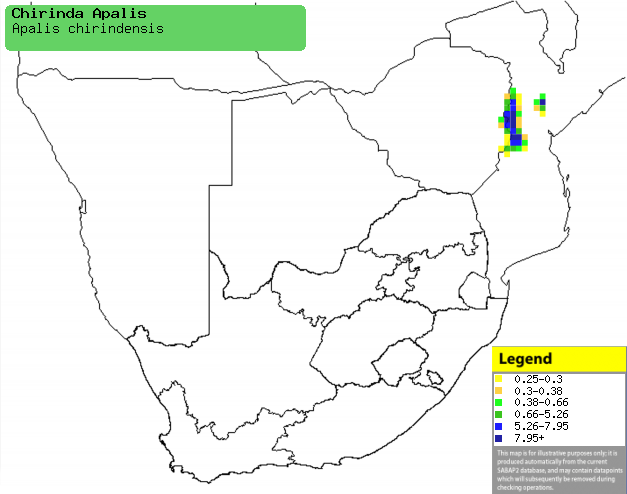|
Apalis chirindensis (Chirinda
apalis)
Gryskleinjantjie [Afrikaans]; Chirinda-apalis [Dutch];
Apalis de Chirinda [French]; Selinds feinsänger [German]; Apalis de Chirinda
[Portuguese]
Life
> Eukaryotes >
Opisthokonta
> Metazoa (animals) >
Bilateria >
Deuterostomia > Chordata >
Craniata > Vertebrata (vertebrates) > Gnathostomata (jawed
vertebrates) > Teleostomi (teleost fish) > Osteichthyes (bony fish) > Class:
Sarcopterygii (lobe-finned
fish) > Stegocephalia (terrestrial
vertebrates) > Tetrapoda
(four-legged vertebrates) > Reptiliomorpha > Amniota >
Reptilia (reptiles) >
Romeriida > Diapsida > Archosauromorpha > Archosauria >
Dinosauria
(dinosaurs) > Saurischia > Theropoda (bipedal predatory dinosaurs) >
Coelurosauria > Maniraptora > Aves
(birds) >
Order: Passeriformes > Family: Cisticolidae
> Genus: Apalis
Distribution and habitat
Endemic to southern Africa, occurring in Zimbabwe's eastern
highlands and central Mozambique. It generally prefers montane forest at quite
high altitudes, although it may head to lowland forest in winter.
|
 |
|
Distribution of Chirinda apalis in southern Africa,
based on statistical smoothing of the records from first SA Bird Atlas
Project (©
Animal Demography unit, University of
Cape Town; smoothing by Birgit Erni and Francesca Little). Colours range
from dark blue (most common) through to yellow (least common). |
Food
It mainly eats insects, such as beetles (Coleoptera),
caterpillars and flies (Diptera).
It often joins mixed-species foraging flocks, gleaning prey from leaves and
branches in the tree canopy.
Breeding
- Then nest is a untidy dome with a side entrance and false entrance on the
top, built of leaves, lichens, ferns and seed cases. It is typically placed
on a small, moss-covered branch, usually around 20 metres above ground.
- Egg-laying season is from October-February.
Threats
Not threatened, although it may be at risk from extensive
clearance of lowland forest.
References
-
Hockey PAR, Dean WRJ and Ryan PG 2005. Roberts
- Birds of southern Africa, VIIth ed. The Trustees of the John Voelcker
Bird Book Fund, Cape Town.
|
